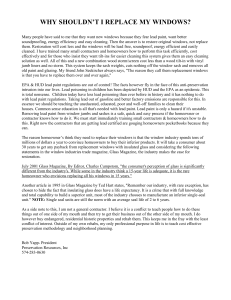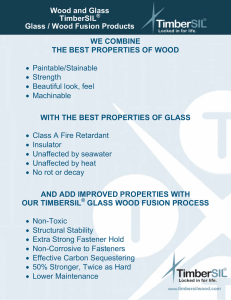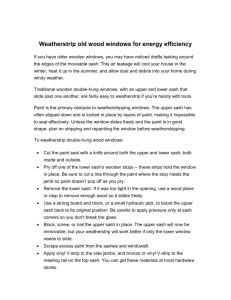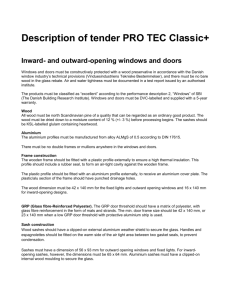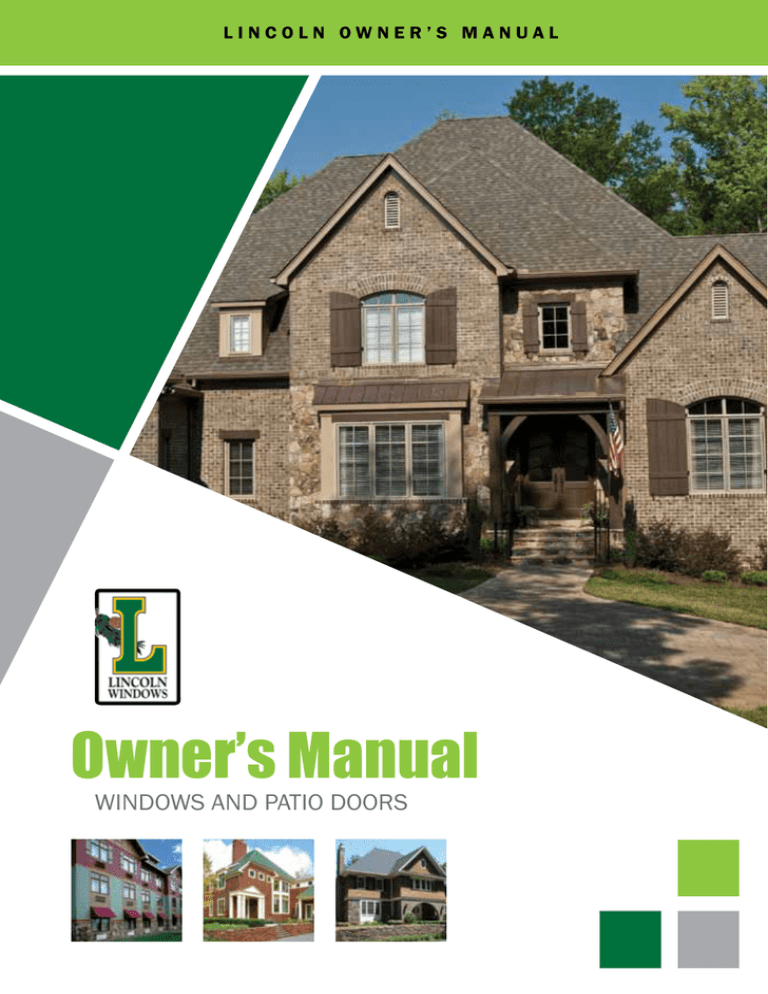
LINCOLN Owner’s Manual
Owner’s Manual
Windows and Patio Doors
Purchase information
Purchased From: Distributor Window & Door Center
Lumber Yard
Other
Name:____________________________________________________________________________
Address: __________________________________________________________________________
City:_______________________________________ State:_ ____________ Zip:__________________
Phone:____________________________________________________________________________
Date of Purchase:___________________________________________________________________
Lincoln Order Number: ______________________________________________________________
Distributor P.O. (Obtain from Your Dealer): ______________________________________________
My Lincoln Windows & Doors were installed by:
Name:____________________________________________________________________________
Address: __________________________________________________________________________
City:_______________________________________ State:_ ____________ Zip:__________________
Phone:____________________________________________________________________________
Type of Installer: General Contractor
Remodeler
Self
Other
Date of Installation:_________________________________________________________________
Type and brand of sealer, primer and top coat used to finish windows and doors.
Sealer:____________________________________________________________________________
Primer:_ __________________________________________________________________________
Top Coat:__________________________________________________________________________
Index
Finishes.........................................................4-6
Cleaning & Maintenance.............................7-8
Casement Windows........................................ 9
Awning Windows............................................ 10
Glider Windows.............................................11
Double Hung Windows..................................12
Slide Patio Doors...........................................13
Swing Patio Doors................................... 14-15
Fold-A-Way Patio Doors................................. 16
Condensation Information...................... 17-19
WELCOME
For more than half a century, Lincoln Wood Products has been dedicated to the production of
quality windows and patio doors. Our products are designed and crafted not only for beauty, but
also for energy efficiency, smooth operation and low maintenance.
Most window and patio door problems encountered by homeowners are avoidable. Simple
measures such as properly cleaning the glass and screens, lubricating locks and hinges and
finish maintenance will help ensure many years of service from your windows and patio doors. With a little care and consideration, your Lincoln windows and patio doors can look and operate
like new for years to come.
Your Lincoln products come with a comprehensive warranty, which is attached to each label on
the product. For a copy of the warranty contact your Lincoln dealer or download one online at
www.lincolnwindows.com.
Window Identification
Most windows consist of two primary components; a
frame and a sash. The frame, which is the portion
attached to your wall, has two side jambs, a head jamb
and a sill. A sash, which is the part that holds the glass,
is made up of two horizontal rails and two vertical stiles
that surround the glass. Sash may be operable or
1
stationary. Direct set windows consist of a frame and
glass – no sash component – and are always stationery.
6
On every window there are glazing beads - small strips of
wood that secure the glass in place. Windows may also
have optional grilles (sometimes called muntin bars). These may be removable interior wood grilles, grilles
between the glass (GBG), true divided lites or simulated
divided lites. Simulated divided lites are permanently
affixed to both the interior and the exterior of the glass
to give the historic appearance of true divided lites while
maintaining today’s energy efficiency requirements.
9
5
3
4
7
8
2
Casement
A window that opens
outward either left
or right with hinges
on the top and
bottom rails.
Awning
A window that
opens outward at
the bottom with
hinges on the left
and right stiles.
Double Hung
A window With
two operating
sash, one sliding
upward and one
sliding downward.
3
Glider
A window with one
operating sash, one
sliding from right to
left or left to right.
1.
2.
3.
4.
5.
6.
7.
8.
9.
Side Jamb
Sill
Sash
Glazing/Glass
Grill/Muntin Bar
Head Jamb
Stiles
Rails
Checkrail
FINISHES
Exterior Finishing
Primed/Natural Wood Products
Wood is a natural material and must be protected from the elements. Initial painting/staining
and regular maintenance is necessary to achieve a long life product. Failure to paint/stain the
exterior of your Lincoln product immediately after installation will void your warranty.
Primed products require painting immediately after installation. Factory priming is intended to
protect products during handling and installation only. Primed products should not be subjected
to long-term exterior exposure. Prior to painting:
A
ll wood surfaces must be lightly sanded to remove any dirt or handling marks. After sanding,
be sure to clean all surfaces to remove any sanding dust.
All nail holes filled.
All cracks sealed with good quality paintable sealant.
A
ll cellular PVC materials cleaned with a good quality multi-purpose cleaner. See Exterior
Finishing – cPVC Components for more information.
Two coats of top quality exterior latex paint are recommended. For proper paint selection see a
qualified paint professional in your area. Be sure to follow the paint manufacturer’s instructions. NOTE: Top coats must lap on the glass by a minimum of 1/16”.
Natural wood products require painting or staining immediately after installation. Prior to painting
or staining:
A
ll wood surfaces must be lightly sanded to remove any dirt or handling marks. After sanding,
be sure to clean all surfaces to remove any sanding dust.
A
ll nail holes filled.
A
ll cracks sealed with good quality paintable sealant.
Because wood is a natural product, variations of wood grain, color or texture may be experienced. Lincoln cannot be responsible for these color variations, and will not consider them a defect. Refer to Lincoln’s Limited Warranty. Consult with your paint professional for proper preparatory
procedures to minimize these differences. A good quality pre-stain sealer is recommended in
order to balance stain absorption between different grain densities of wood. Follow the paint
manufacturer’s application recommendations for this process.
Pre-stain sealer, stain and two coats of varnish or primer and two finish coats of paint are
recommended. NOTE: Top coats must lap on the glass by a minimum of 1/16”.
Sash of windows and panels of doors should be painted/stained in an open position or removed
completely from the unit. Allow paint/stain to dry thoroughly before reinstallation or closing of
window/door products. Be sure to protect any vinyl parts or weatherstripping from contact with
paint/stain. Paint/stain may cause these materials to harden or become brittle and not perform
their intended function. Do not paint/stain any parts that rely on friction contact for performance,
(i.e. sash edges of glider and double hung windows). On all other units except the glider and
double hung, the sash edges should be painted or stained.
Patio door panels must be sealed on all edges. Six sides for wood doors, five sides for clad
doors. Patio doors both wood and clad must be sealed immediately after installation (see door
sticker). After installation, install handle set to avoid water and moisture from getting into door. 4
FINISHES
Lincoln Wood Products, Inc. cannot be responsible for a door product that is not properly sealed
or maintained. Improper painting or finishing of your Lincoln window/patio door products will
void your warranty.
Field applied accessories, such as brickmould, spread mulls, panning systems, etc. and assembly
of Lincoln fabricated products by others are not included in Lincoln’s warranty.
cPVC Components
Some Lincoln products utilize Cellular PVC (cPVC) material on exterior parts. Cellular components
replace traditional wood materials in rot-prone areas. This may include exterior trims, sills and
sill nosing. These white cPVC parts do not require painting (they only need to be cleaned with a
good quality multi-purpose cleaner); however we recommend the sealing of all nail holes, cracks
and gaps on the exterior.
If you choose to paint the cPVC parts, the use of 100% acrylic latex primer and exterior latex paint
is recommended for application of light colors only (L Value of 50 or lighter). Example: Sherwin
Williams Duration paint with VinylSafe color technology – available in 100 standard colors or
custom colors using their Sher-Color computer custom matching system.
If a dark color (L Value of 50 or darker) paint is used, excess solar heat may be absorbed,
subjecting the cPVC material to warping and distortion due to extremes of thermal expansion and
contraction. This reaction is even more evident when these parts are exposed to direct sunlight
in hot climates. Paint adhesion loss, blistering and peeling could also result.
NOTE: Lincoln does not recommend painting cPVC parts with dark color paints unless a good
quality heat reflective paint is used, and that it is applied according to the paint manufacturer’s
recommended application instructions. Failure to use heat reflective dark color paints on Cellular
PVC parts will void your warranty and Lincoln will not be responsible for repair or replacement
of any resulting damage due to distortion, warping, paint blistering, or peeling of paint on the
Cellular PVC parts. Consult your paint professional for proper paint selection.
5
FINISHES
Interior Finishing
Just as with the exterior wood surfaces, raw interior wood surfaces also require finishing
immediately after installation. Lincoln recommends painting over our factory applied primer
immediately after installation. FirstFinish interiors require one additional top coat. Prior to
painting or staining:
A
ll wood surfaces must be lightly sanded to remove any dirt or handling marks. After sanding,
be sure to clean all surfaces to remove any sanding dust.
A
ll nail holes filled.
P
rimed interior – Apply two coats of high quality interior paint.
F
irstFinish interior – Apply one coat of high quality interior paint.
Because wood is a natural product, variations of wood grain, color or texture may be experienced. Lincoln cannot be responsible for these color variations, and will not consider them a defect. Consult
with your paint professional for proper preparatory procedures to minimize these differences. A good quality pre-stain sealer is recommended in order to balance stain absorption between
different grain densities of wood. Follow the paint manufacturer’s application recommendations
for this process.
Pre-stain sealer, stain and two coats of varnish or primer and two finish coats of paint are
recommended. NOTE: Top coats must lap on the glass by a minimum of 1/16”.
Sash of windows and panels of doors should be painted/stained in an open position or removed
completely from the unit. Allow paint/stain to dry thoroughly before reinstallation or closing of
window/door products. Be sure to protect any vinyl parts or weatherstripping from contact with
paint/stain. Paint/stain may cause these materials to harden or become brittle and not perform
their intended function. Do not paint/stain any parts that rely on friction contact for performance,
(i.e. sash edges of glider and double hung windows). On all other units except the glider and
double hung, the sash edges should be painted or stained.
Patio door panels must be sealed on all edges. Six sides for wood doors, five sides for clad
doors. Patio doors both wood and clad must be sealed immediately after installation (see door
sticker). After installation, install handle set to avoid water and moisture from getting into door. Lincoln Wood Products, Inc. cannot be responsible for a door product that is not properly sealed
or maintained. Improper painting or finishing of your Lincoln window/patio door products will
void your warranty.
6
CLEANING & MAINTENANCE
Glass Cleaning
Routine Cleaning
Clean the glass as soon as dirt and or debris become apparent. Products such as Windex® and
Sparkle® work well for routine hand cleaning. A mixture of one part vinegar with ten parts water
is also an excellent cleaning product. Lincoln does not recommend alcohol-based or ammoniabased cleaners as they tend to leave visible streaks.
Start cleaning at the top of a particular wall or window and work your way down. Apply the liquid
liberally to the glass surface and wipe with a lint free towel or cloth. Use a squeegee or clean soft
cloth with clean water, to remove the cleaning solution from the glass as well as the frame and
surrounding materials. To prevent streaking, stop wiping when the glass is almost dry and there
is still a uniform film of moisture on the glass. This film will quickly evaporate leaving a clean
surface. NOTE: Do not wipe with a dry cloth or when the surface is dry.
Spot Cleaning
For stubborn dirt or foreign materials, such as grease, oil, tape adhesive, paint and even crayons,
standard glass cleaner may not suffice. For these instances, products such as Soft Scrub®,
Denatured Alcohol, Acetone or Goof-Off® should be used.
Apply a small quantity of the liquid to a clean WET cloth. Rub on the surface requiring spot
cleaning. Wipe clean and follow up with the routine cleaning procedure given above. NOTE: Do
not wipe with a dry cloth or when the surface is dry.
Dual Low-E Glass
The interior of the surface of the Dual Low-E Glass has a thin pyrolytic coating which gives it an
improved thermal performance. The low emissivity coating has a very fine, hard texture which
requires a slightly different cleaning procedure when compared to regular glass.
Routine Cleaning and Spot Cleaning
Follow the Glass Cleaning procedures above with one exception - Never use a squeegee on the
low emissivity surface.
Specialized Cleaning
While metallic objects, such as razor blades or steel wool should never be used to clean glass
surfaces, it is especially important when working with Dual Low-E glass. The low-emissivity
surface on the interior of the glass is actually harder than the metallic objects and a thin layer of
the metal may be removed from the object and deposited on the surface of the glass which may
appear as a ‘stain’ or ‘scratch’. These cannot be removed by routine cleaning. For the removal
of metal marks, you will need to use products such as Acid Magic®, Steel Glo® or Muriatic Acid.
Apply a small quantity of the liquid to a clean wet cloth and rub on the glass surface until the mark
is removed. Wipe clean and follow up with the routine cleaning procedure to remove any residue
left by the specialized cleaning liquids. NOTE: Do not wipe with a dry cloth or when the surface is
dry. NOTE: Never spray products such as Acid Magic®, Steel Glo® or Muriatic Acid directly on the
glass surface. The over-spray of these liquids may damage non-glass window components such
as wood, vinyl or silicone.
7
CLEANING & MAINTENANCE
Neat® & Preserve®
Follow the Glass Cleaning procedures for Neat® glass. Neat® glass products should require less
maintenance on the exterior.
Lincoln recommends removing Preserve® films within six months of installation. Follow the Glass
Cleaning procedures if glass cleaning is required.
Precautions & Warnings
D
o not use power washers or garden hoses to clean windows.
D
o not use metal scrapers of any kind or allow metal parts of cleaning equipment to contact
glass. The Lincoln warranties do not cover glass scratched by scrapers, razor blades, or tools.
D
o not use abrasive cleaners on the glass surface.
D
o not clean windows in direct sunlight.
D
o not allow cleaning solutions to dry on glass or surrounding surfaces.
W
indows and doors should be protected when using abrasive or caustic cleaners on products
around windows. Brick wash acids, abrasive cleansers and the like can all damage the
surfaces of glass as well as the finish of vinyl and metal parts.
Screen Cleaning
To clean your screen of dust and light debris you may use the upholstery brush supplied with your
vacuum cleaner. Heavier debris such as kitchen grease may be removed by gently scrubbing with
mild soap and a soft brush. Screens should be rinsed to remove dirt and soap residue. Be sure
that screens are dry before they are re-installed.
General Maintenance
All Lincoln products require periodic inspection and maintenance. Inspect your Lincoln product at
least annually. How often maintenance is required will differ based on local climates, exposure,
amount and quality of finish used. Should you notice any signs of separation from wood, cracking
or peeling paint, or gapping between materials, scrape or sand affected area and reseal with
paint or caulk. Caulk all cracks or separations with a paintable quality sealant. Clean aluminum
clad and vinyl products with mild soap and water. Aluminum clad can be waxed with a light
automotive type wax to renew luster. Failure to properly maintain your Lincoln product will void
your warranty.
8
CASEMENT WINDOWS
Screen Removal
Crank-out casement screens are mounted on the interior
of the window. The screen is held in place by springs at the
top. To remove the screen, lift the rail at the bottom and
pull up and back over the operator. Once the operator is
cleared simply pull the screen down and into the building.
Exterior Glass Cleaning
Your Lincoln casement is provided with standard
hardware that will allow you to open the window to a full
90° which will allow access to clean the exterior of the
window when the screen is removed and the sash is fully
opened. NOTE: Casement windows with special egress
hardware will not allow this reach out feature. These
windows will need to be washed from the outside.
Hinge Adjustment
Should the sash to frame relationship fall out of
adjustment over time (the space between sash and
frame equally spaced around the unit), the hinges are
adjustable.
70°
Track Maintenance
To help keep your casement windows operating smoothly
it is important that the tracks and hinges are cleaned of
dirt and debris on a regular basis. To keep these parts
clean, brush them with a small dry paintbrush. Lubricate
with a Teflon spray if necessary.
9
AWNING WINDOWS
Screen Removal
Crank-out awning screens are mounted on the interior of
the window. The screen is held in place by springs on the
top. To remove the screen, lift the rail at the bottom and
pull up and back over the operator. Once the assembly
is cleared, simply pull the screen down and into the
building.
Exterior Glass Cleaning
Once the screen is removed, crank the window open 30°
to 45°. At this point you may pull the retainer clip back
and lift the arm locking mechanism away from the slide
shoe mounted on the sash track.
With this disconnected you will be free to lift the sash
to 90° which will enable you to reach out to wash the
outside of the sash. IMPORTANT: After the sash is
disconnected it must be held open by blocking it in place
or with the aid of another person.
Hinge Adjustment
In the event you should experience hinge chatter or
bouncing during closing on your awning, you may tighten
the small screw located on the hinge shoe. Tighten the
screws on each hinge shoe equally until the problem is
corrected. Be careful not to over tighten the screws.
Track Maintenance
To keep your Lincoln awnings operating smoothly it is
important to keep the hinge tracks free of dirt and debris. To keep the tracks clean, brush them with a small dry
paintbrush. Lubricate with a Teflon spray if necessary.
10
70°
GLIDER WINDOWS
Screen Removal
Unlock the window and move operating sash to cover
the stationary sash (fully open position). Grasp the
two plungers, located on the side of the screen, and
simultaneously pull them toward the center of the screen
while pushing the screen outward. With the full screen
option, this may require two people. When the exterior
of the window frame has been cleared, grasp the sides
of the screen frame and pull down and out. Rotate the
screen approximately 45° and pull to the building’s
interior.
Sash Removal
Move the inside sash toward the stationary sash and
past the anti-lift device (sash should be centered). Grasp
both sides of the sash and lift to clear the bottom track. In order to replace the glider sash, simply reverse the
removal process.
Track Maintenance
Occasionally you will need to clean the head and sill
tracks using a mild soap and water solution (do not use
abrasives or solvents or any cleaner that may contain
petroleum distillates of any kind on these parts). As
needed, a light coat of paraffin wax or spray furniture
polish may be applied to the tracks in order to lubricate
them.
11
DOUBLE HUNG WINDOWS
Screen Removal
Raise the bottom sash as far as possible. Grasp the
two screen plungers, near the bottom of the screen,
simultaneously pull them toward the center of the screen
and push the screen outward. When the exterior of the
window frame has been cleared, grasp the sides of the
screen frame and pull down and out. Rotate the screen
approximately 45° and pull the screen to the building’s
interior.
Sash Tilting & Removal
For cleaning purposes, double hung sash may be tilted
in and/or removed. To tilt, unlock and raise the bottom
sash approximately 4” to 6”. Tilt latches are located on
each side of the bottom sash check rail. Simultaneously
push both release levers toward the center of the sash. This will allow the sash to be tilted toward the inside of
the building.
Carefully tilt the sash in. At 90° the carriage blocks
will lock in place so that they will not raise or fall in the
jambliner. For complete removal tilt sash 90°. In this
position, lifting one side of the sash higher than the other
will allow removal of the sash from the frame. If need
be, the sash can be tilted past 90° and gently rested on
the sill to facilitate cleaning the outside of the sash from
inside the building.
The top sash may also be tilted and/or removed. Lower
the sash 4” to 6”. The top sash tilt latches will be visible
on the top rail. Following the same release procedure as
the bottom sash will allow the top sash to be tilted and/
or removed for cleaning. Reverse process to replace or
reposition sash. NOTE: To tilt the top sash the lower sash
must already be either tilted or removed.
Jambliner Maintenance
Cleaning the jambliners with soap and water will aid in
smooth operation.
12
SLIDE PATIO DOORS
Operating Panel Adjustment
If your slide patio door panel does not operate smoothly it
can be adjusted via the two adjustment screws located at
the bottom inside face of the operating panel.
To adjust the door, remove the plugs covering the
adjustment screws. Using a Phillips screwdriver adjust the
operating panel up or down being sure to keep the panel
square with the lock side jamb. Turning the adjustment
screws clockwise will lower the door panel while turning
the screw counter clockwise will raise the panel. Be sure
to replace the plug covers after the adjustments are
completed. This will help to keep the rollers clean. After
your door is adjusted, latch and keeper adjustment may
be necessary.
Lock and Keeper Adjustment
To make sure that your patio door closes correctly,
the keeper may be adjusted up or down until the latch
engages properly. It is also possible to tighten or loosen
the latch mechanism on the door by using the adjustment
screw on the edge of the latch.
Screen Adjustment
If your rolling patio screen does not operate smoothly, it
may be adjusted via the two adjustment screws located
at the bottom vertical screen frame edge. Use a small
Phillips screwdriver to adjust the bottom rollers up or
down until the screen rolls smoothly. Make sure to keep
the screen square to the lock side jamb.
Track Maintenance
It is important that the sill track be kept free of dirt
and debris. To clean, vacuum loose dirt and debris as
necessary. Wash tracks with mild soap and water as
needed. There are weep holes on the exterior edge of
the sill and at both jamb edges viewed from the interior. They must be kept free of dirt and debris.
13
SWING PATIO DOORS
Hinge Adjustment
Lincoln swing patio doors are equipped with SET hinges
and GUIDE hinges that can be adjusted to square the
operating panel within the frame. Set hinges allow for
1/8” vertical adjustment-hex head screw is located
under the hinge pin finial cap. The guide hinge provides
1/8” of horizontal adjustment and has a visible hex head
adjustment screw on the leaf face. Prior to adjusting,
determine that the frame is plumb, square and level
in the rough opening. If discrepancies are found, take
corrective action on the frame prior to adjusting hinges.
These instructions denote a right-hinged door viewed
from the inside. If door is left hinged, simply reverse the
procedures. Maintain approximately 1/8” of clearance
at the head jamb. After adjusting be sure and check the
latch operation.
Non-removable
Hinge Pin
Door
Sash Leaf
Frame
Sash Leaf
Required tools:
• 3/16” hex wrench
• Flat head screwdriver
• Plastic putty knife
Squaring the Door Within the Frame
6/6, 6/8 and 7/0 height doors are equipped with three
hinges; 8/0 & 9/0 high doors have four hinges. The
top hinge moves the upper part of the door, the center
hinge(s), will adjust the panel vertically and the bottom
hinge will move the base of the door. When adjusting,
hinges should be manipulated to ensure approximately
3/32” clearance on the hinge side.
A. To pull the door closer to the hinges, turn the
horizontal adjustment screws counter clockwise.
B. To push the door closer to the latch jamb, turn the
horizontal adjustment screws clockwise.
14
Vertical
Adjustment
Screw
Finial Cap
Horizontal
Adjustment
Screw
SWING PATIO DOORS
Operating Panel Adjustments
Vertical Adjustments
1. Remove the press-fit finial cap from the bottom of
the set hinge to expose the adjustment screw. Use a
small screw driver for plastic finial caps and the putty
knife for brass caps.
2. Insert the hex wrench in the bottom of the set hinge. Tighten the screw to raise the panel and loosen to
lower the panel.
3. Reinstall the finial cap removed in step 1.
4. For doors with two set hinges, establish desired
height with the top-most set hinge. Adjust other set
hinge as follows: turn adjustment screw 1/8 turn past
the onset of resistance to distribute the panel weight
evenly.
Horizontal Adjustments
1. Insert a 3/16” hex wrench into the horizontal
adjustment screw.
2. Turn clockwise to decrease the margin and
counterclockwise to increase the margin on the hinge
side.
Sill Maintenance
It is important that the sill be kept free of dirt and debris. To clean the sill, vacuum when necessary. Wash sill with
mild soap and water if needed. Always be sure that weep
holes on the inside and the outside of the sill are free of
dirt and debris. If necessary the retention chamber of the
passive weep system can be blown out with compressed
air.
15
Fold-A-Way PATIO DOORS
Carrier Pin Adjustment
Components come with a plastic shipping clip installed.
1. Insert a flat-bladed screwdriver into the slot and
rotate the pin.
2. When correct adjustment is reached, remove the
shipping clip.
3. Carrier pin will snap into place when the blade and
slot are aligned.
4. To readjust, pull the blade down to disengage it from
the slot, replace the shipping clip and rotate the pin.
5. Remove shipping clip after final adjustment.
Wall Pivot Adjustment
1. Locate screwdriver slot.
2. Insert flat-bladed screwdriver into slot and rotate.
3. Utilize both top and bottom wall pivots to maximize
adjustment range.
Track Maintenance
It is important that the sill track be kept free of dirt and
debris. To clean the sill, vacuum when necessary. Wash
tracks with mild soap and water if needed. Always be
sure that weep holes on the inside and the outside of the
sill are free of dirt and debris. If necessary the retention
chamber of the passive weep system can be blown out
with compressed air.
16
CONDENSATION Q&A
Introduction
This information will review some of the causes of condensation and some helpful hints to relieve
the situation. Please keep in mind that windows and patio doors are not the cause of the problem,
rather they are an indicator of a greater problem.
Condensation
Condensation is the fog that is evident on the glass of your windows. This is the same fog that
appears on the outside of a cold glass during the summer.
Condensation is actually the result of high humidity levels in your home. It generally appears
as moisture or ice on the interior of the glass. The problem is more visible on the glass of your
windows because the surface condenses more easily. This means that the glass has the lowest
temperature of any visible surface in your home. It needs to be noted that if moisture is visible
here, it could be happening elsewhere as well. Problems such as peeling paint, rotting wood,
mildew or moisture spots are typical symptoms of condensation.
The cause of the condensation is too much moisture in the air in relation to the temperature of the
surface on which the moisture condenses. When warm air meets a cooler surface, it condenses. This creates the visible moisture you see on the surface of your windows which is similar to your
cool glass windshield of your car being misted over on a damp fall morning. The windshield glass
is not defective rather it is colder than the dew point for the amount of moisture in the surrounding
air. Condensation also occurs when the flow of warm air is restricted from reaching window
surfaces causing the warm moist air to cool and loose its ability to retain higher moisture levels.
Humidity
Humidity is the amount of moisture in the air. It may come from various sources. Your home
needs a certain amount of moisture, but deciding how much you need is a critical decision.
The following recommended humidity levels will help you with the moisture level of your home;
reducing humidity while maintaining comfort. It is based on the inside relative humidity for a 70°
indoor temperature. It is also important to note that for each degree cooler than 70° the interior
relative humidity should be reduced an extra 2%-4%.
+20° F & Warmer
+10° F
0° F
-10° F
-20° F
35-40%
30-35%
25-30%
20-25%
15-20%
If there is moisture on your windows, it is important to check your entire home. Problem areas
could reveal themselves as damp spots on ceilings and walls. The end result could be the moisture
passing through the walls, insulation, and to the exterior walls causing peeling or blistering paint
or other damage anywhere there is a vapor barrier. This could eventually cause rotting of the
frame of the building if left untreated.
17
CONDENSATION Q&A
Causes of Humidity
As stated before, moisture may come from a variety of sources. The following is a list of average
daily living activities and how much moisture a family of four contributes to their living environment,
which can add up to more than 18 gallons of water per week.
Normal Breathing.......................1/2 pint per hour
Cooking 3 meals a day..............4-5 pints per day
Showering...................................1/2 pint each
Plants..........................................1 pint per day/per plant
A New Home
When a new home is built, a great deal of moisture is released from the building materials such as
wood or plaster. Since newer homes are manufactured more air-tight, there is typically no outlet
for the humidity to escape unless steps are taken to vent the moisture during construction and
the first few heating and cooling cycles. During the winter months in cooler climates, the moisture
will be released into your home. This circumstance usually occurs only during the initial heating
season.
Location and Time
Some regions are more prevalent to condensation than others. Generally areas that reach 35°
Fahrenheit or below in the winter months are more susceptible to condensation.
Interior condensation is more likely in the initial heating months of winter or during a severe, rapid
change in temperature over a short period of time during the winter. This happens when moisture
in the air contacts a surface whose temperature is lower than the dew point (the temperature in
which air manufactures dew). This symptom should gradually dissipate during the season.
Exterior surface condensation usually occurs on sultry, humid summer days, typically when an air
conditioner is being used. This creates a surface temperature on the glass below the dew point.
Humidity within a home will fluctuate at different times of the day as well. Generally the highest
humidity readings occur at night or in the morning when the occupants are conducting the daily
activities that cause humidity levels to rise such as bathing, cooking and laundry. Type of Window
Some window types, such as bays and bows, are more subject to condensate. Because they are
more exposed to the environment, these windows may be somewhat cooler. Also, due to their
shape, there is a lack of air movement within the window.
One solution to this problem is to make sure that the window is properly insulated upon installation. Contact your contractor or insulation specialist for further details. Another solution is to use a fan
to promote air circulation.
Window Coverings
Another concern might be the type of window coverings that are being used. Those that are close
to the windows restrict the flow of warmer air and can contribute to a condensation problem.
18
CONDENSATION Q&A
Reducing Humidity
Existing Homes
There are several steps that you can take to reduce your indoor humidity level. The most important
one is to make sure your home is properly vented.
Install vents in all areas such as attics and crawl spaces and make sure they are always unblocked. Many people cover attic vents or louvers for the winter thinking that they are keeping cold air out,
not realizing that they are also keeping moisture in.
Install exhaust fans in rooms with high humidity levels such as bathrooms and kitchens. Make
sure they are used during and long after taking a bath/shower and cooking. Also make sure
that exhaust fans and appliances, such as clothes’ dryers and gas heaters, are properly ducted,
sealed and vented to the exterior of the home, not into a crawl space or attic. Gas appliances
should be a major concern. Water vapor is one of the by-products of gas combustion.
Lincoln highly recommends the use of an air exchanger. Combined with the use of ceiling fans
and dehumidifiers, condensation can be drastically reduced. A temporary solution for severe
cases would be to open a window in each effected room for a short period of time.
For more specifics on these and other ideas, we recommend consulting a heating and ventilation
specialist.
New Construction Homes
When planning your new home, here are some helpful suggestions that should be considered in
addition to those mentioned for existing homes:
Choose a wood window instead of a metal one. Wood is a much better insulator than metal. Also,
make sure your windows and doors are Energy Star™ certified. Make sure that your contractor
has considered the most appropriate way to keep soil moisture from permeating the basement or
foundation. Proper insulation is one of the most valuable tools in any energy efficient residence. But many people often forget their water pipes and cold air ducts. Any pipes (such as cold water
pipes) or ducts that condensate in the warmer months should be covered with insulation that has
an exterior vapor barrier.
19
When only the best will do.
Choose Lincoln for your new construction, remodeling
or even light commercial projects. With over 60 years
of manufacturing experience built into every unit, we
engineer our windows and patio doors for visual appeal
as well as outstanding performance and back it up with
exceptional customer service before and after the sale. We are continually expanding our list of product offerings,
options, and accessories and are confident that we have
the perfect window or patio door to harmonize with your
ideas and designs.
Lincoln Windows & Doors
carry an extensive product
warranty. Ask your dealer
for complete information.
Committed to protecting and
preserving the environment.
Lincoln Windows is committed to
environmental stewardship. As
responsible corporate citizens, we
are dedicated to manufacturing
energy efficient products and
managing our resources in a
manner that reduces our impact on
the environment.
Lincoln Wood Products, Inc.
1400 W. Taylor Street • P.O. Box 375
Merrill, Wisconsin 54452-1355
715-536-2461 • Fax: 715-536-7090
www.lincolnwindows.com
LOM201007-V1
2010 Lincoln Wood Products, Inc. All rights reserved. Product specifications subject to change without notice. Photography used may not represent current Lincoln product features and options.

